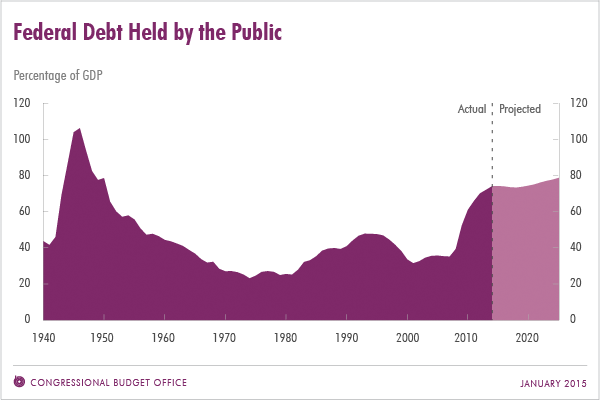Deficit & Debt Will Start Growing Again
The federal budget deficit, which has fallen sharply during the past few years, is projected to hold steady relative to the size of the economy through 2018. Beyond that point, however, the gap between spending and revenues is projected to grow, further increasing federal debt relative to the size of the economy—which is already historically high.
Those projections by CBO, based on the assumption that current laws governing taxes and spending will generally remain unchanged, are built upon the agency’s economic forecast. According to that forecast, the economy will expand at a solid pace in 2015 and for the next few years—to the point that the gap between the nation’s output and its potential (that is, maximum sustainable) output will be essentially eliminated by the end of 2017. As a result, the unemployment rate will fall a little further, and more people will be encouraged to enter or stay in the labor force. Beyond 2017, CBO projects, real (inflation-adjusted) gross domestic product (GDP) will grow at a rate that is notably less than the average growth during the 1980s and 1990s.
...
The agency’s projections beyond the next few years are not based on estimates of cyclical developments in the economy, because the agency does not attempt to predict economic fluctuations that far into the future; instead, those projections are based on estimates of underlying factors that affect the economy’s productive capacity.
For 2020 through 2025, CBO projects that real GDP will grow by an average of 2.2 percent per year—a rate that matches the agency’s estimate of the potential growth of the economy in those years. Potential output is expected to grow much more slowly than it did during the 1980s and 1990s primarily because the labor force is anticipated to expand more slowly than it did then. Growth in the potential labor force will be held down by the ongoing retirement of the baby boomers; by a relatively stable labor force participation rate among working-age women, after sharp increases from the 1960s to the mid-1990s; and by federal tax and spending policies set in current law.

